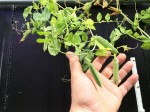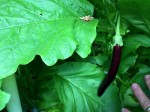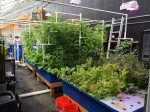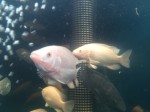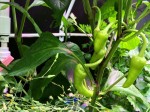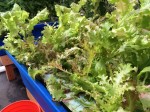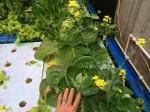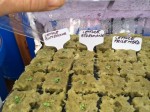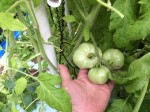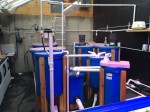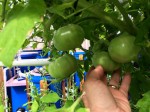Plant Rafts with Sprouting Blocks
I utilize six plant rafts, each 4’X6’, for a total of 144 square feet of growing area. Each tank has room for three 2’x4’ polystyrene 1” thick rafts. Each raft has 27 one-inch holes made to accept rock wool sprouting blocks. These are commercially available on Amazon or most hydroponic source stores online. Each block will hold several sprouted plants (if you want to grow multiples on the block) or a single sprout if you prefer. Larger plants, like cabbage, take more room between plants than vertical growers, like tomatoes. Fully planted with (for a new set up) lettuce plants, you can have 487 plants in the system at one per wool cube. This system will produce as much food as one acre planted in northern climates, and it produces all year long and grows plants significantly faster.)
Light and Minerals
I do keep 1000 watts of LED grow lamps high above each pair of plant raft tanks. This helps during the short winter days and extends the length of day from 5am to 9pm every day of the year when the sun angle is low to the rafters. I do keep all fish tanks covered with polystyrene to reduce algae growth and prevent tilapia from jumping out of the tanks. They only need enough light (small hole in each poly cover) to see their food. The food of course is the only input into the system, unless you add mineral supplements, which I highly suggest you do with new systems. Iron, particularly, as well as zinc are rapidly utilized. There are several products– Flourish, Flourish Trace, and others– that are useful. I suggest you purchase a laboratory grade pH meter and calibrate it often. Purchase mineral test kits, ammonia, nitrate, and nitrite test kits, as well as test kits for iron, calcium hardness, total dissolved solids, and potassium. The better handle you have on your water quality, the faster you will be able to react to deficiencies in your system before they appear as yellow spots on your growing plants.
Air
Air is delivered by two very large redundant commercial air pumps. They pump air around the system in 1-inch PVC that is adapted down at the point of the airstone. All air delivery systems are located above the water to prevent siphoning. Only the stones are in the water. There are eight, large, silica airstones in each plant raft tank under the polystyrene to provide oxygen to the roots, four large stones in the gasification/degassification tanks, four stones in each of the fish tanks, and six stones each in each of the four glass tanks for a total of 92 BIG airstones in the system. Air is mission critical, so 24/7 power is a big thing.
Heat
The main heater for the system is an industrial 12 AMP 220 volt inline heater that senses water flow through it for safety. It has a digital thermostat and has never missed a beat. I do have a couple of smaller aquarium heaters in the glass refuge tanks for a little warmer conditions there, if necessary, and as backup for the inline system should it fail. (I also keep redundant pumps/heaters/thermostats and so forth on premises.)
Maintenance and Feeding
Maintaining the system is certainly a daily chore. Typically, it requires no more than an hour or so, depending on the day. Feeding small fish is a four time a day job. Larger fish require feeding twice or three times, if you want them to grow fast. You have to run some chemical tests and do some cleaning and crop work, but there is NO WEEDING AT ALL!!!Tomato plants need pinching, tending, tying up when blooms set, and so forth. Flowering plants need artificial bumble bees (a vibrating tooth brush will do) to pollinate. I find that big wall fans will do most of the work for me though, particularly with sweet peas. The clarifier tanks get about 10 gallons dumped per day each out the bottom drain valve, which purges all the fish waste out of the system and a couple of fish per clarifier disturb the tanks walls to help let material settle to the bottom. Occasionally, one of those fish gets the flush and ends up on the floor. If I don’t see it immediately, they turn into dried fish chips in the sun. Since I have roughly 400 smaller fish in the system, this is an acceptable, though undesired, occasional loss as are suicide jumpers. I pressure wash the floor, which is epoxied, to get the fish poop off of it. You can alternately collect the waste water and pour it on your fruit trees. It’s really good stuff for them. The glass tanks need surface algae removed to be able to see the fish occasionally, which is important for breeders. The plastic tanks hide the fish, so an underwater viewer (bucket with a clear plastic bottom) is needed to see the population inside. You need to feed the fish an appropriate-sized fish food pellet in amounts that balance the waste levels to what the plants will consume. What fish eat in the span of five minutes is appropriate. You can see from the amount of foliage my system supports, with multiple crops even, I feed over four ounces of pellets a day for the system. I have multiple sizes of fish, so multiple sizes of food is necessary. I am currently using five different sizes of feed. I keep the bagged feed sizes I’m not using in a freezer to extend their longevity.
Seeds
I am using heirloom seeds when I can and have had excellent results getting seeds to replant in the system. Using indeterminate tomatoes will eventually make me grow them horizontally along trellises using the areas above fish tanks for growing area. All the crops are healthy, happy, and disease free so far. Note to tobacco users/chewers/snuff users: Stay out of aqua/hydroponic operations. Dried tobacco has tobacco mosaic virus mixed in. Users shed viruses all of the time. This nasty virus will kill tomatoes, and the presence of it will necessitate the sterilization of the whole facility (kill fish, kill plants, et cetera) to eliminate it. Word for the wise, if you smoke don’t try this technology. Instead, quit. I keep a bug zapper (UV) running in one corner to keep any bugs at bay, and I use a mosquito net (double) over the intake vents of the fan system to keep out the “nasties” in the summer.
Cost
Your cost varies on the system you decide to start and the structure (if any) you decide to build/construct. I easily have 125,000 dollars into this project. Industrial projects start at 1.5 million dollars and go up from there. There are less expensive ways to do this, but few are more productive from the space/quantity of produce perspective. I’ve seen shoestring systems put up for hundreds of dollars using used tanks, but be sure that they are food quality and were never poisoned with solvents et cetera. Your ingenuity can fly with this. I hope you are good with PVC plumbing. There are over 500 pieces of PVC involved in my project. I lost count months ago. If you have an existing greenhouse, it is a good dovetail into your operation, as long as you can keep the system warm. My first salads were coming in at 10 grand a dish. They are getting way cheaper now after several a day. The payback time (as with most preps) will be down the road when fresh veggies are unavailable at any price.
EMP
A thinking observer will ask, what about EMP? It will shut down your system. Probably. I can instantly turn the system into a non-circulating hydroponic system, as Dr. Kratky describes in the link above. I’ve still got the pit greenhouse to start plants way earlier, and I’m generally better off than most if the EMP shuts down systems. I’ll have lots of smoked fish for a while too, as well as wrinkled hands after filleting hundred of Tilapia all at once.
To summarize, veggies are going to get expensive and some unobtainable. If you like it, you should grow it. There are many easy ways to provide for your family, ranging from standard gardening and canning to non-circulating hydroponic and even aquaponic systems. All systems are scalable to your space-budget considerations. The science is critical but not tough. The time to study is now as skills are not easily learned when the Shumer really hits the oscillating air movement device.
“In one century we went from teaching Latin and Greek in high school to offering remedial English in college.” – Joseph Sobran
